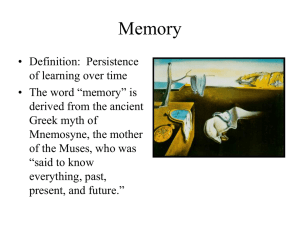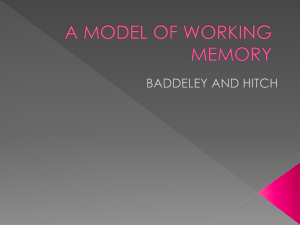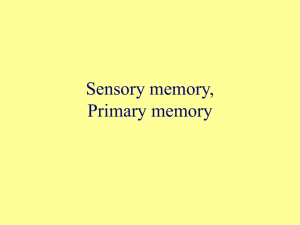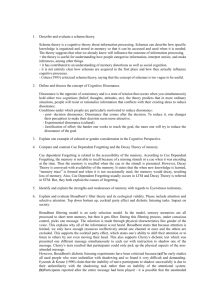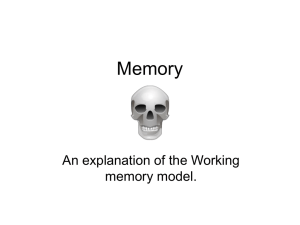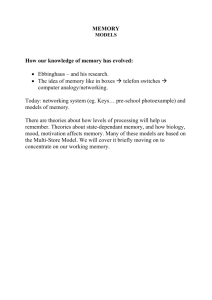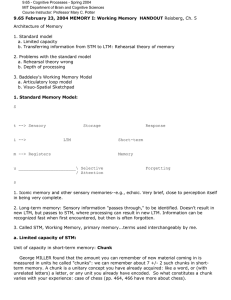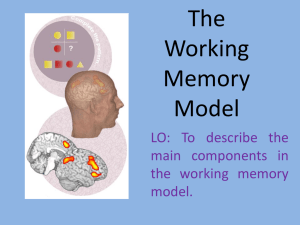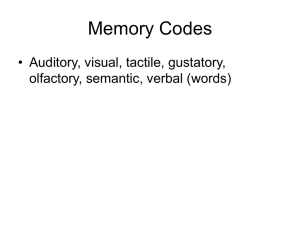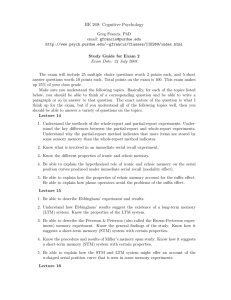Working Memory Model: Lesson Plan & Activities
advertisement
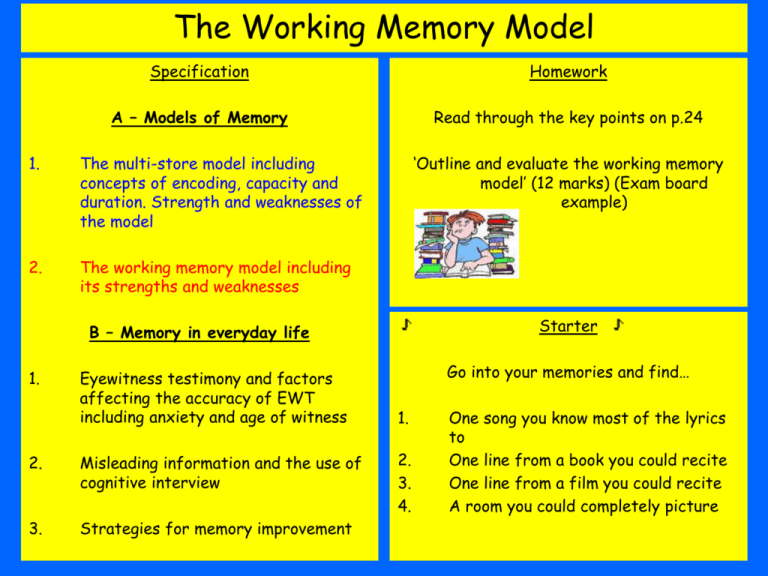
The Working Memory Model Specification Homework A – Models of Memory Read through the key points on p.24 1. The multi-store model including concepts of encoding, capacity and duration. Strength and weaknesses of the model 2. The working memory model including its strengths and weaknesses ‘Outline and evaluate the working memory model’ (12 marks) (Exam board example) Starter B – Memory in everyday life 1. Eyewitness testimony and factors affecting the accuracy of EWT including anxiety and age of witness 2. Misleading information and the use of cognitive interview 3. Strategies for memory improvement Go into your memories and find… 1. 2. 3. 4. One song you know most of the lyrics to One line from a book you could recite One line from a film you could recite A room you could completely picture The Working Memory Model Baddeley and Hitch questioned what short term memory was for, they contested Atkinsons and Shiffrin’s model which looks at the idea of STM as a unitary store Dual task technique: participants are asked to carry out a primary task while also engaging in a secondary task. Performance is compared to performance on each of the tasks when done individually Baddeley and Hitch claimed that the case of KF (who had a digit span of two yet could transfer memory to his LTM) suggests that STM is not a unitary store To test this idea they devised the dual task technique Lets try it! Method: Perform a reasoning task while simultaneously reciting aloud a list of six digits Hypothesis: If digit span is a measure of maximum STM capacity, participants would be expected to show impaired performance on the reasoning task because their STM would be fully occupied with retaining the six digits Get into pairs/threes Participant: Recite the number 482917 while ticking true/false on your sheet Experimenter: Watch how long it takes the participant to complete the task and how many answers are correct Conclusions STM must have more than one component and must be involved in processes other than simple storage. Baddeley and Hitch envisaged STM as a workspace where a variety of operations could be carried out on both old and new memories. Two tasks can be carried out simultaneously in STM provided that they are being dealt with by different parts of the memory system. Baddeley and Hitch envisaged LTM as passive store that maintains previously learned material for use by the STM when needed. The working memory model: Lets build it! The working memory model has three main components: 1. Central Executive 2. Phonological Loop 3. Visuo-Spatial Sketchpad Get into four groups and work on understanding the WMM using p. 19 - 20. You must draw a diagram. You will then need to explain it to another group – prize for the best team! Prepare for an exam question…. Central Executive Phonological Loop Visuo-spatial sketchpad Articulatory control system Where is the evidence loop) to(articulatory prove this model? Inner scribe Phonological store Visual Cache Eye on the Exam A.) Outline key features of the working memory model. (6 marks) AO1 = 6 marks For identification of components of the model and brief outline of their function Likely features are the three main components: • Central executive, in charge of co-ordinating the other two slave systems, involved in attention and higher mental processes. It has limited capacity and can process information from any mode. • Phonological loop involved in holding speech-based information and articulatory control processes inner speech • Visuo-spatial scratchpad deals with visual/spatial information and is involved in pattern recognition, perception of movement. Eye on the Exam B.) Four of the statements are descriptions of different components of the working memory model. (4 marks) A. B. C. D. E. Stores acoustically coded items for a short period Stores and deals with what items look like and the physical relationship between them Encodes data in terms of its meaning Acts as a form of attention and controls slave systems Silently repeats works that are heard or seen Components of working memory model Phonological store Visuo-spatial sketch pad Articulatory process Central Executive Descriptions of components Evidence for the WMM Work in three groups to conduct experiments which provide evidence for the existence of: 1. Central Executive (p.23) 2. Phonological Loop (p.21) 3. Visuo-Spatial Sketchpad (p.21) Phonological Loop ‘Romeo, Romeo, Wherefore art thou Romeo’ Remember this? Its stored in your phonological loop! Visuo-Spatial Sketchpad Can you count how many windows there are in your home? Its stored in your visuo-spatial sketchpad! Strengths and Weakness of the WMM + Strengths + - Weaknesses - + Most cognitive psychologists now use the term WM instead of STM - Exact role played by the central executive remains unclear + More plausible that the MSM as it explains STM in terms of temporary storage and active processing + Incorporates verbal reasoning as an optional process in the articulatory loop instead of being the sole means of transferring information + Can account for findings that are difficult for MSMs to explain + Evidence that PL plays a key role in the development of reading, it is not present in some children with dyslexia + Accounts for individual differences in memory processing - It is questionable whether the central executive can be a single component or whether there are separate verbal and spatial working systems - Cowan has suggested that in order to explain abilities such as text comprehension , working memory should encompass some kind of long term memory activation - Berz criticises the model for failing to account for musical memory because we are able to listen to music without impairing performance on other acoustic tasks. Eye on the Exam Identify and explain one weakness of the working memory model (4 marks) Identify and explain one strength of the working memory model (4 marks) You’re hired…??? The US air force has devised a WMM test, which it uses to test it potential employees Consider the following questions: 1. What sort of things are the US air force wanting to test in their potential employees? 2. What results would they be looking for in an ideal applicant? 3. Do you think a WMM test is a good way to test potential employees? 4. Would you get in? Why?

